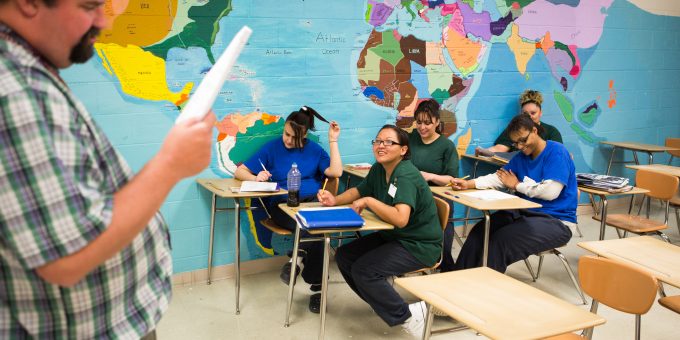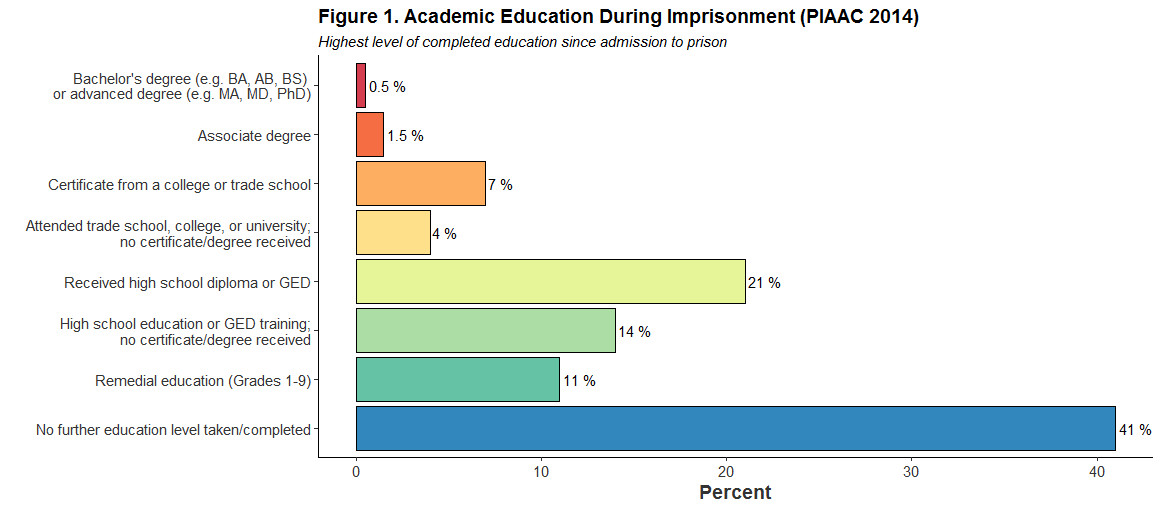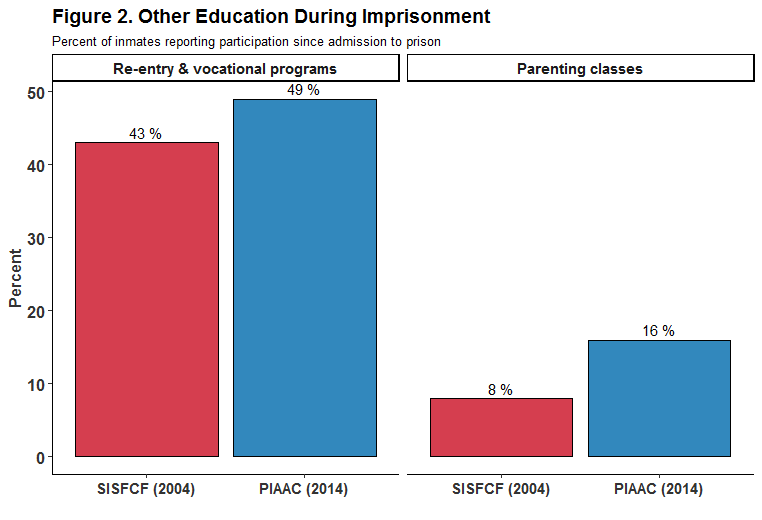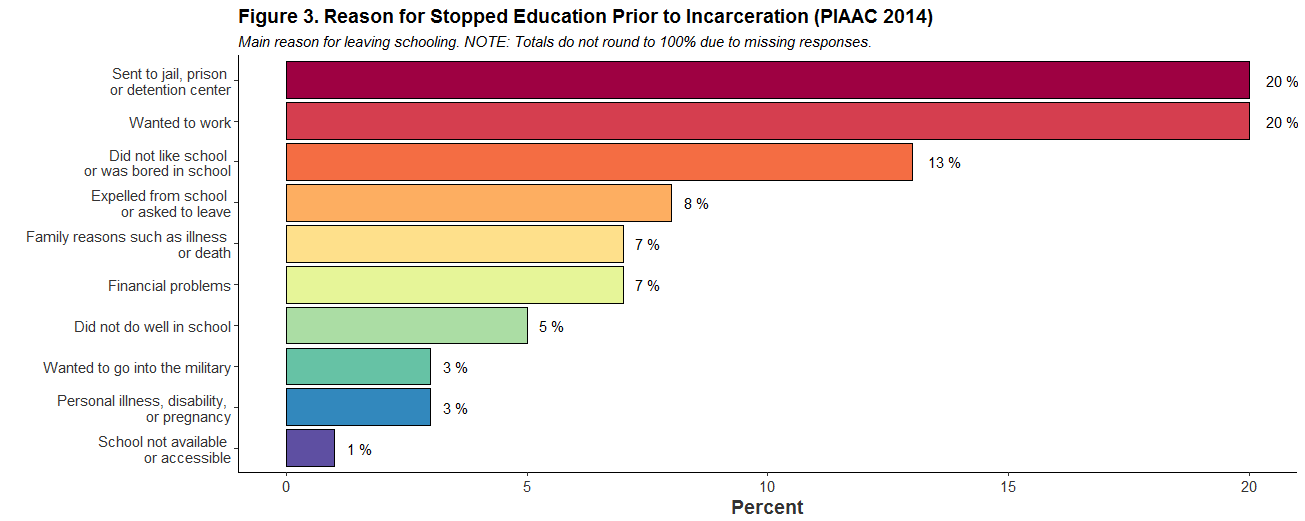
Up until the 2016 presidential election, criminologists saw increasingly hopeful signs that a new “smart on crime” political alignment was emergent: imprisonment rates (and crime) were declining, tough-on-crime policies were becoming increasingly unpopular among both Democrats and Republicans, and “rehabilitation” was reentering the criminal justice lexicon. In this context, in-prison programming – once considered a staple of liberal “coddling of offenders” – could potentially make a come-back. Yet at the same time, corrections departments’ budgets have been cut, leading some prisons to embrace austerity measures.
As states and the federal system increasingly turn toward “evidence-based” practices, have they supported prison education as a smart investment or pulled back from providing these services? Results from a new survey of prisoners, completed by the U.S. Department of Education’s National Center for Education Statistics in 2014 as part of the Program for the International Assessment of Adult Competencies (PIAAC), suggests that prisoners are indeed reporting more participation in academic programs, vocational and job-related training, and parenting programs. However, these programs still remain woefully inadequate to meet the needs of prisoners.The last data point available on rates of prisoner participation in these types of programs is from the Bureau of Justice Statistics’ 2004 Survey of Inmates in State and Federal Correctional Facilities (SISFCF).i As I argued on Sociological Images, these data show that prisoners face severe educational deficits: over 60 percent of state inmates in 2004 reported that they had not made it past 11th grade in school. In addition, prisons were increasingly failing at meeting this need, with rates of participation in academic programs cut by almost half between 1991 and 2004. At the same time, however, participation in soft-skills “re-entry” programs was growing.
The new PIAAC prisoner data allows us to track how these trends have shifted in the past decade. While the two surveys are not identical, they do have several overlapping measures. Both draw from a stratified random sample of state and federal prisoners that allows us to estimate national prevalence rates. In addition, the PIAAC’s extensive educational data provide rich information on prisoners’ educational pathways that are unavailable in the SISFCF.

As shown in Figure 1, the PIAAC data show that just under half of prisoners (41 percent) reported that they had not enrolled in or completed an educational program during their current period of incarceration.ii However, fully 21 percent reported having received their high school diploma or GED since admission. Another 14 percent have participated in high school or GED programs without completing the degree and 11 percent participated in remedial education programs. Among the inmates reporting participation in high school or GED classes, 35 percent had earned a diploma or GED by the time of the survey. And while 7 percent had completed a college certificate or trade school program (with another 4 percent attending college or trade school programs without completing a certificate or degree), less than 2 percent had completed an Associate degree. A vanishingly small percent (less than 1) had completed a Bachelors or advanced degree.
As shown in Figure 2, rates of participation in various kinds of life-skills, job readiness, re-entry, and vocational training programs slightly increased over this period as well, growing from 43 percent of surveyed inmates in 2004 to 49 percent in 2014.iii In addition, rates in parenting or child-rearing classes doubled from 8 percent in 2004 to 16 percent of inmates participating since admission.iv
 The PIAAC also provides a more holistic assessment of prisoners’ educational desires, intentions, and histories. The majority (63 percentv) of surveyed prisoners in 2014 reported that they would like to be enrolled in an academic class or program of study. Yet only 21 percent of prisoners are currently enrolled in a formal degree or certificate program. Among those who would like to be enrolled in a program, desire was the greatest for trade school certificates as well as traditional academic programs (from GEDs through Bachelor degrees).
The PIAAC also provides a more holistic assessment of prisoners’ educational desires, intentions, and histories. The majority (63 percentv) of surveyed prisoners in 2014 reported that they would like to be enrolled in an academic class or program of study. Yet only 21 percent of prisoners are currently enrolled in a formal degree or certificate program. Among those who would like to be enrolled in a program, desire was the greatest for trade school certificates as well as traditional academic programs (from GEDs through Bachelor degrees).
Finally, the PIAAC asked prisoners why they stopped their schooling prior to incarceration. As displayed in Figure 3, the most common responses were that education was stopped by getting locked up or wanting to work instead. These results echo the concerns of other scholars about the substantial barriers disadvantaged young people face in completing their education.

While President Donald Trump campaigned on a regressive “law-and-order” platform, it is an open question how much his administration will support criminal justice reform. Regardless, local and state-level governments will continue to drive policies. If the commitment to “evidence-based” practices is more than rhetoric, we should see access to educational programs inside of prisons continue to increase.
Recommended Readings
Jason A. Ford and Ryan D. Schroeder. 2011. “Higher Education and Criminal Offending over the Life Course.” Sociological Spectrum 31:32-58.
Amy E. Lerman. 2013. The Modern Prison Paradox: Politics, Punishment, and Social Community. Cambridge University Press.
Michelle S. Phelps. 2011. “Rehabilitation in the Punitive Era: The Gap Between Rhetoric and Reality in U.S. Prison Programs.” Law & Society Review 45(1): 33-68.
RAND Corporation. 2013. “Evaluating the Effectiveness of Correctional Education: A Meta-Analysis of Programs That Provide Education to Incarcerated Adults.” Research report.
Carla Shedd. 2015. Unequal City: Race, Schools, and Perceptions of Injustice. Russell Sage Foundation.
Endnotes
i A new survey in this collection was fielded in 2016 so we should have more data available soon.
ii This outcome is a composite measure of several questions in the prison PIAAC survey. The base is a question that asks “During your current period of incarceration, what is the highest level of education you completed?” The possible responses included: 1. Grades 1-6, 2. Grades 7-9, 3. High School Diploma or GED, 4. Pre-associate education, 5. Attended trade school, college, or university; no certificate or degree received, 6. A certificate from a college or trade school for completion of a program prior to the associate/bachelor’s degree, 7. Associate degree, 8. Bachelor’s degree (e.g. BA, AB, BS), 9. Master’s degree (e.g. MA, MS, MEng, MEd, MSW, MBA), 10. Professional degree (e.g. MD, DDS, DVM, LLB, JD), 11. Doctorate degree (e.g. PhD, EdD), 12. No further education level completed.
For inmates listed as not completing a level of education, I changed their educational status to program participation without completion if they reported participation in academic programs. These questions asked about whether inmates had participated in classes or tutoring since admission “to improve your basic reading, writing, and math skills?” (remedial education) or “to prepare to take the General Educational Development test, or GED?” and “some other high school equivalency program or adult high school program” (high school and/or GED).
iii To construct this category, I summed across several overlapping questions in each survey. These are the SISFCF questions:
- “Since your admission, have you…”
- “joined or participated in employment counseling (including how to find a job or interviewing skills)?”
- “joined or participated in classes in life skills and community adjustment (including anger management, conflict resolution, personal finance, etc.)?“joined or participated in other pre-release programs?”
- “been in any vocational or job-training program, excluding prison work assignments?”
These are the PIAAC questions:
- “During your current incarceration, have you …”
- “attended employment readiness or re-entry classes (including how to find a job or interviewing skills)?”
- “attended classes in life skills such as personal finance, problem solving, decision making?”
- “participated in a job skills or job training program, for example, a computer skills program that teaches Microsoft Word? Please exclude prison jobs.”
iv This question was identical in the two surveys, asking if inmates had attended classes in “parenting or child rearing skills” since admission / during the current incarceration.
v This variable has an unusually high number of missing or “don’t know” responses. If only non-missing responses are included, 70 percent of inmates would like to be involved in an educational program.

Comments